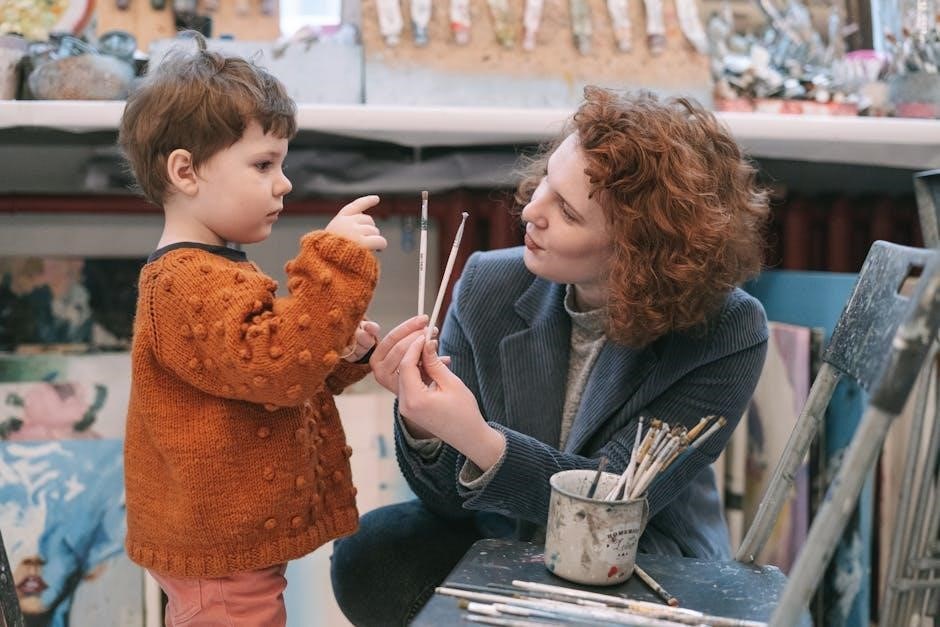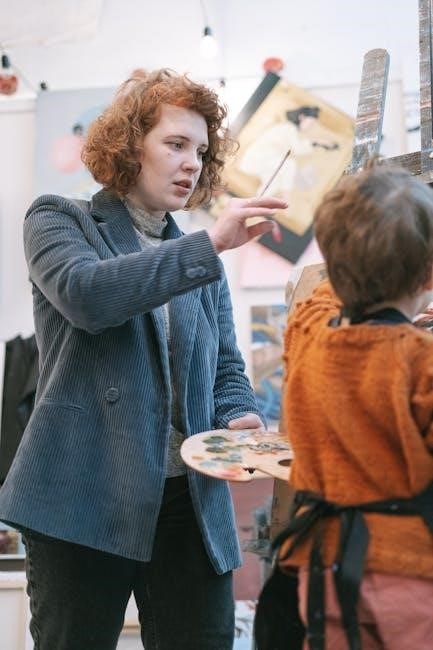The Interaction of Color explores how colors behave and influence each other‚ emphasizing the relativity of color perception. Josef Albers’ seminal work reveals that color is always context-dependent.
1.1 Historical Background of Josef Albers’ Work
Josef Albers‚ a German-born artist and educator‚ laid the foundation for modern color theory through his groundbreaking work. Associated with the Bauhaus movement‚ he explored color’s emotional and perceptual effects. After fleeing Nazi Germany‚ Albers continued his research in the U.S.‚ teaching at Yale University. His innovative approach emphasized hands-on experimentation‚ challenging traditional color theories. In 1963‚ he published Interaction of Color‚ a seminal book that transformed art education. Albers’ teachings highlighted color’s relativity and context-dependent nature‚ influencing generations of artists‚ designers‚ and educators. His legacy endures as a pioneer in understanding and applying color in creative fields.
1.2 Importance of Color in Visual Perception

Color plays a pivotal role in shaping visual perception‚ as it influences how we interpret and experience the world around us. Josef Albers’ work underscores that color is rarely perceived in isolation but is profoundly affected by its surroundings. The brain processes color contextually‚ meaning the same hue can appear different depending on adjacent colors. This relativity of color perception is central to Albers’ teachings. Understanding these interactions is crucial for artists and designers‚ as it allows them to manipulate visual effects‚ evoke emotions‚ and guide the viewer’s eye. Color’s dynamic nature makes it both a powerful tool and a complex phenomenon to master.
1.3 Overview of the Book “Interaction of Color”
Interaction of Color‚ written by Josef Albers‚ is a groundbreaking guide that explores the dynamic properties of color and its effects on human perception. Originally conceived as a teaching tool‚ the book delves into the relativity of color‚ demonstrating how colors change based on their context and surroundings. It emphasizes practical exercises and experiments to understand these interactions. The text is accompanied by interactive studies‚ including digital versions like PDFs‚ which allow readers to explore color relationships visually. This comprehensive resource has become a cornerstone in art and design education‚ offering insights into the complex and ever-evolving nature of color and its applications.

Basic Principles of Color Interaction
This section introduces the foundational concepts of color interaction‚ including the relativity of color perception‚ simultaneous contrast‚ and how context influences color appearance and perception of hue‚ saturation‚ and light.
2.1 The Relativity of Color Perception
The relativity of color perception highlights that a color’s appearance is not fixed but influenced by its surroundings. As demonstrated in Interaction of Color‚ the same color can look vastly different when placed in varied contexts. This principle challenges the notion of absolute color properties‚ emphasizing instead the dynamic interplay between colors. Josef Albers’ experiments reveal how hue‚ saturation‚ and light collectively shape perception‚ proving that color differences are often caused by both hue and light. This concept underscores the subjective nature of color‚ where our eyes perceive color relative to its environment‚ not in isolation.
2.2 Hue‚ Saturation‚ and Light in Color Differences
Hue‚ saturation‚ and light are fundamental factors influencing color differences. Hue refers to the actual color itself‚ while saturation describes its intensity or purity. Light plays a crucial role in how these elements are perceived‚ as it alters the appearance of colors. In Interaction of Color‚ Josef Albers demonstrates that even slight changes in hue or saturation can significantly impact how colors are seen. Additionally‚ the presence or absence of light can transform a color’s perceived brightness and tone. This interplay highlights the complexity of color perception‚ showing how these three variables work together to create distinct visual effects and illusions. This understanding is essential for effective color design.
2.3 Simultaneous Contrast and Its Effects
Simultaneous contrast‚ a key concept in Interaction of Color‚ explains how the perception of a color is influenced by its surrounding colors. Josef Albers illustrates that when two colors are placed side by side‚ each appears changed due to the other. This phenomenon affects both hue and value‚ creating optical illusions where colors may seem brighter‚ darker‚ or even altered in tone. For instance‚ a gray square on a black background appears lighter‚ while the same gray on a white background looks darker. This principle underscores the relativity of color perception and its dependence on context‚ making it vital for artistic and design applications. By understanding simultaneous contrast‚ creators can manipulate color interactions to achieve desired visual effects.
2.4 The Role of Context in Color Appearance
Context plays a pivotal role in shaping color appearance‚ as demonstrated in Interaction of Color. A color’s perception is never isolated; it is profoundly influenced by its surroundings‚ including adjacent colors‚ lighting conditions‚ and spatial arrangement. Josef Albers highlights that the same color can appear vastly different when placed in varied contexts. For instance‚ a medium gray may seem lighter against a dark background and darker against a light one. This contextual dependency underscores the relativity of color perception‚ emphasizing that color is not an absolute property but a dynamic experience shaped by its environment. This principle is fundamental to both artistic expression and practical design applications‚ where understanding context is essential for achieving intended visual effects. By recognizing how context alters color appearance‚ creators can harness these interactions to guide viewer perception and enhance compositional impact.

Color Contrast and Its Applications
Color contrast enhances visual impact by creating differences in hue‚ value‚ or chroma. It guides perception‚ improves readability‚ and adds aesthetic appeal in art‚ design‚ and branding.
3.1 Types of Color Contrast: Hue‚ Value‚ and Chroma
Hue refers to the actual color name‚ like red or blue. Value is the lightness or darkness of a color‚ while chroma is its purity or saturation; These contrasts influence how colors are perceived. Hue contrast creates visual tension‚ value contrast affects readability‚ and chroma contrast adds vibrancy. By manipulating these elements‚ designers and artists achieve balance and emphasis in compositions. Understanding these principles is essential for effective color application in various mediums‚ from graphic design to fine art‚ as explored in Interaction of Color.
3.2 Mixing Complementary Colors and Their Effects

Mixing complementary colors creates intriguing effects‚ as they are pairs of colors opposite on the color wheel. When mixed in equal chroma‚ they produce middle gray‚ neutralizing each other. This interaction highlights the relativity of color perception‚ as each color appears more intense when paired with its complement. For example‚ blue and orange together enhance each other’s vibrancy. This principle is explored in Josef Albers’ Interaction of Color‚ where he demonstrates how such mixtures can create illusions of brightness and depth. These effects are foundational in art and design‚ helping artists achieve balance and visual interest in their work.
3.3 Color Harmony in Design and Art
Color harmony is achieved when colors work together to create a visually appealing effect. In Interaction of Color‚ Josef Albers explores how harmony is not fixed but dependent on context. Techniques like complementary‚ analogous‚ and triadic color schemes are discussed. Complementary colors‚ such as blue and orange‚ create vivid contrasts‚ while analogous colors‚ like blue‚ green‚ and yellow‚ offer smooth transitions. Albers emphasizes that harmony is subjective and influenced by cultural and psychological factors. His teachings inspire designers and artists to experiment and understand how colors interact‚ fostering creativity and balance in their compositions. This approach remains a cornerstone in modern design education and practice.
3.4 Practical Examples of Color Contrast in Design
Color contrast is a powerful tool in design‚ enhancing readability and visual impact. For instance‚ using complementary colors like blue and orange creates striking highlights. High contrast between light and dark shades improves text legibility. Designers often apply simultaneous contrast to manipulate perceptions‚ making colors appear brighter or duller. These techniques are evident in branding‚ where bold contrasts capture attention. Digital interfaces use contrast to guide user focus. Understanding these principles‚ as outlined in Interaction of Color‚ helps designers create balanced and effective compositions‚ ensuring elements stand out while maintaining harmony. Practical examples showcase how color contrast can elevate both aesthetic and functional aspects of design.

The Science Behind Color Interaction
The science behind color interaction explains how colors behave perceptually‚ shaped by light‚ context‚ and psychological factors. The book offers insights into these complex interactions;
4.1 The Color Wheel as a Tool for Understanding Interactions
The color wheel is a fundamental tool for understanding how colors interact. It organizes hues in a circular format‚ showing relationships between primary‚ secondary‚ and complementary colors. Josef Albers used the color wheel to demonstrate how colors can create harmonious or contrasting effects. By studying the wheel‚ one can explore how mixing complementary colors produces neutral tones and how adjacent colors influence perception. The wheel also illustrates the principles of simultaneous contrast‚ where colors appear different based on their surroundings. This tool is essential for artists and designers‚ offering practical insights into color harmony and interaction‚ as detailed in Albers’ work.
4.2 Psychological Impact of Colors on Human Perception
Colors profoundly influence human emotions and perception‚ shaping experiences and decisions. Research shows that hues like red evoke energy and excitement‚ while blue conveys calmness and trust. These psychological effects are rooted in cultural and personal associations‚ as well as biological responses. For instance‚ warm colors like orange and yellow often stimulate‚ while cool tones like green and purple relax. The context in which colors are viewed amplifies their impact‚ as demonstrated in Josef Albers’ studies. Understanding these psychological dimensions is crucial for designers‚ marketers‚ and artists aiming to evoke specific emotions or convey messages effectively through color. This knowledge enhances visual communication and engagement.

4.3 The Role of Light and Its Influence on Color
Light is the essential factor in color perception‚ as it determines how colors appear and interact. The intensity‚ angle‚ and type of light significantly alter color properties. Natural light‚ for instance‚ reveals colors differently than artificial light‚ affecting hue‚ saturation‚ and value. Josef Albers emphasized that color perception is relative and deeply influenced by lighting conditions. The same color can look vastly different under varying illumination‚ highlighting the dynamic relationship between light and color. This understanding is vital for artists and designers‚ as it impacts how colors are experienced and interpreted in different environments and lighting scenarios. Light transforms color perception entirely.
4.4 Color Blindness and Its Relation to Color Interaction
Color blindness affects how individuals perceive color interactions‚ altering their ability to distinguish certain hues. Common forms‚ like red-green color blindness‚ impact color contrast and harmony. Josef Albers’ work highlights the relativity of color perception‚ emphasizing that color appearance varies depending on context and individual vision. This condition underscores the importance of understanding color interaction‚ as it influences how colors are experienced differently by individuals. Artists and designers must consider color blindness to ensure accessibility and effectiveness in their work. By addressing this aspect‚ Albers’ teachings provide valuable insights into the subjective nature of color perception and its broader implications in art and design education.

Color Interaction in Art and Design
Josef Albers’ Interaction of Color emphasizes how color relationships shape artistic expression and design principles‚ offering practical insights for creating dynamic visual effects through color combinations and contrasts.
5.1 The Use of Color Interaction in Graphic Design
Color interaction is fundamental in graphic design‚ where visual hierarchy and emotional resonance are achieved through strategic color relationships. Josef Albers’ principles‚ as outlined in Interaction of Color‚ guide designers in creating dynamic compositions. Understanding how colors influence each other enables the effective use of contrast‚ harmony‚ and context. Designers leverage color contrast to draw attention‚ convey messages‚ and enhance readability. Albers’ teachings emphasize the relativity of color perception‚ encouraging designers to experiment with hue‚ saturation‚ and light. By applying these concepts‚ graphic designers can craft visually compelling and meaningful designs that engage audiences and communicate effectively. This approach remains a cornerstone of modern design practice.
5.2 Color Interaction in Fine Arts and Painting
Color interaction is a cornerstone of fine arts and painting‚ where artists use chromatic relationships to evoke emotions and create visual depth. Interaction of Color by Josef Albers offers insights into how colors can be manipulated to achieve specific effects. Artists employ simultaneous contrast‚ complementary colors‚ and contextual influences toguide the viewer’s eye. The interplay of hue‚ saturation‚ and light enables painters to craft dynamic compositions that explore perceptual phenomena. Albers’ teachings encourage experimentation‚ pushing artists to see color not as fixed entities but as relational elements. This approach has inspired generations to innovate and explore the infinite possibilities of color in their work.
5.3 The Role of Color in Branding and Marketing
In branding and marketing‚ color interaction plays a pivotal role in shaping consumer perceptions and emotions. Interaction of Color highlights how colors can influence brand identity by evoking specific feelings. Marketers use color contrast and harmony to create visually appealing campaigns that resonate with target audiences. The strategic use of complementary colors enhances brand recognition‚ while subtle color variations can convey different brand values. Understanding color psychology allows marketers to tailor their strategies‚ ensuring that their messaging aligns with consumer emotions. This application of color theory demonstrates how the principles explored in Albers’ work extend beyond art into the realm of commerce and communication.
5.4 Color Interaction in Digital Interfaces and UI/UX Design
In digital interfaces and UI/UX design‚ color interaction is crucial for creating intuitive and visually appealing user experiences. Designers leverage principles from Interaction of Color to enhance readability‚ guide user attention‚ and evoke emotions. The strategic use of color contrast ensures that text and elements stand out‚ while harmonious color schemes promote a cohesive design. Tools like Adobe Color and interactive PDFs enable designers to experiment with color relationships digitally. Understanding how colors behave on screens is essential‚ as light emission affects perception differently than print. By applying Albers’ teachings‚ designers can craft interfaces that are both functional and aesthetically engaging‚ improving overall user satisfaction.

Digital Tools and Resources for Color Interaction
Digital tools like interactive PDFs‚ Adobe Color‚ and online courses offer innovative ways to explore and study color interactions‚ enhancing learning and practical applications for designers and artists.
6.1 Interactive PDFs and Digital Color Studies
Interactive PDFs and digital color studies revolutionize how we explore color theory. These tools allow users to engage with color principles dynamically‚ creating and exporting custom interactive plates in formats like SVG and PDF. The new edition of Interaction of Color features over 60 color studies‚ enabling hands-on experimentation. Digital platforms also offer video tutorials‚ enhancing understanding. This format makes complex color interactions accessible‚ fostering deeper learning and creativity for artists and designers. The ability to save and share work streamlines collaboration‚ making digital color studies an indispensable resource in modern education and design practice.
6.2 Software for Exploring Color Interaction (e.g.‚ Adobe Color)
Software like Adobe Color offers powerful tools to explore and visualize color interactions. Users can create custom color palettes‚ experiment with harmony rules‚ and study how colors behave together. The color wheel feature allows for precise adjustments of hue‚ saturation‚ and lightness. Additionally‚ real-time collaboration enables designers to share and refine concepts. Other tools like Canva‚ Figma‚ and Photoshop provide similar functionalities‚ making color interaction accessible to both professionals and educators. These platforms also simulate effects like simultaneous contrast and value shifts‚ aligning with Josef Albers’ teachings. By leveraging such software‚ users can deepen their understanding of color dynamics and apply it to practical projects.
6.3 Online Courses and Tutorials on Color Theory
Online platforms like Coursera and Udemy offer comprehensive courses on color theory‚ inspired by Josef Albers’ teachings. These courses cover foundational concepts such as color harmony‚ contrast‚ and the color wheel. Interactive tutorials allow learners to explore how colors interact in different contexts‚ simulating Albers’ hands-on approach. Topics include the relativity of color perception and practical exercises for understanding color dynamics. These resources are ideal for both students and professionals seeking to enhance their understanding of color principles and their applications in art‚ design‚ and digital media‚ aligning with the educational legacy of Interaction of Color.
6.4 Apps and Tools for Creating Color Palettes
Modern apps and tools simplify the process of creating color palettes‚ aligning with Josef Albers’ principles of color interaction. Adobe Color and Canva offer intuitive interfaces for experimenting with color harmony and contrast. These platforms allow users to explore complementary colors‚ analogous schemes‚ and custom palettes‚ fostering creativity and precision. Additionally‚ apps like Color Hunt provide inspiration by showcasing pre-curated palettes. Such tools are invaluable for designers and artists‚ enabling them to apply the concepts from Interaction of Color in practical‚ digital workflows. They also support real-time collaboration and export options‚ making them essential for modern design projects.

The Role of “Interaction of Color” in Education
Interaction of Color revolutionized art education by offering practical exercises and interactive studies‚ enabling students to explore color theory through hands-on experimentation and digital tools.
7.1 Josef Albers’ Teaching Methods and Philosophy
Josef Albers’ teaching methods emphasized hands-on experimentation and visual exploration‚ discouraging formulaic approaches to color. He believed color should be experienced‚ not just theorized‚ fostering a deep understanding of its relativity. His philosophy centered on the idea that color is a means of exerting a direct influence on the soul‚ making it a powerful tool in art and design. Albers’ interactive exercises‚ as outlined in Interaction of Color‚ encouraged students to explore color relationships through practical studies. This approachable‚ experimental methodology has left a lasting impact on art education‚ inspiring future generations to engage with color in a dynamic and creative way.
7.2 How the Book Has Influenced Art Education
Interaction of Color revolutionized art education by shifting focus from color theory to practical experimentation; Albers’ emphasis on hands-on learning transformed how color was taught‚ encouraging students to explore and understand color relationships through exercises. The book’s interactive approach and focus on perception made it a foundational text‚ influencing generations of artists and educators. Its impact lies in demystifying color theory‚ making it accessible and applicable across disciplines. Today‚ the book remains a cornerstone in art and design curricula‚ inspiring innovative teaching methods and fostering a deeper understanding of color’s dynamic role in visual communication.
7.3 Practical Exercises for Understanding Color Interaction
Josef Albers’ Interaction of Color introduces exercises that engage students in exploring color relationships. One notable exercise involves creating color swatches to demonstrate simultaneous contrast‚ where a color’s appearance changes based on its surroundings. Another exercise explores complementary colors‚ showing how mixing two colors can produce varying tones and hues. These hands-on activities encourage experimentation and observation‚ helping students grasp how context influences perception. The exercises are designed to be interactive‚ fostering a deeper understanding of color principles through experience rather than theory alone. This practical approach has made the book a valuable resource for both educators and learners in art and design.
7.4 The Book’s Legacy in Modern Art and Design Education
Interaction of Color remains a cornerstone in art and design education‚ influencing curricula worldwide. Its innovative approach to teaching color theory through practical exercises has inspired generations of artists‚ designers‚ and educators. The book’s emphasis on understanding color relationships and perception has made it a foundational text‚ adapting to modern tools like digital apps and interactive PDFs. Albers’ teachings continue to shape how color is studied and applied‚ ensuring his legacy endures in contemporary education. The book’s principles are now integrated into digital platforms‚ making its timeless insights accessible to new learners‚ solidifying its role as a pivotal resource in art and design education.
Interaction of Color remains a foundational text‚ influencing modern art and design education. Its principles‚ now enhanced by digital tools‚ continue to inspire future color studies and applications.
8.1 The Relevance of “Interaction of Color” Today
Josef Albers’ Interaction of Color remains highly relevant today‚ offering timeless insights into color theory and perception. Its principles‚ such as simultaneous contrast and color relativity‚ are essential in modern design‚ branding‚ and digital interfaces. The book’s interactive PDFs and digital tools have made its teachings more accessible‚ inspiring new generations of artists and designers. Albers’ emphasis on experimental learning aligns with contemporary educational approaches‚ ensuring his work continues to influence both traditional and digital art forms. The integration of color studies into UI/UX design and marketing further underscores its enduring impact on visual communication and creative industries worldwide.
8.2 Evolving Understanding of Color Interaction
Our understanding of color interaction has evolved significantly‚ enriched by technological advancements and psychological insights. Digital tools like interactive PDFs and software enable dynamic exploration of color principles‚ expanding beyond traditional methods. Modern research highlights how colors influence emotions and cognition‚ adding depth to Albers’ foundational theories. The application of color interaction in UI/UX design‚ branding‚ and marketing demonstrates its practical relevance. Additionally‚ the recognition of color perception’s subjectivity and context-dependence continues to refine our knowledge. These developments ensure that the study of color remains vibrant and adaptable‚ bridging art‚ science‚ and technology in innovative ways. Color’s dynamic nature keeps inspiring new discoveries and applications.
8.3 The Role of Technology in Advancing Color Studies
Technology has revolutionized color studies‚ offering tools like interactive PDFs and software such as Adobe Color. These platforms enable precise color palette creation and exploration‚ enhancing learning and application. Digital resources provide access to Albers’ principles through interactive plates and video tutorials‚ making complex concepts accessible. Apps and online courses further democratize color education‚ allowing artists and designers to experiment globally. Technology also facilitates the study of color perception‚ including simulations for color blindness. This integration of tech and theory ensures that color interaction remains a dynamic and evolving field‚ bridging traditional art education with modern digital practices. Innovation continues to expand our understanding.
8.4 Final Thoughts on the Importance of Color Interaction
Interaction of Color underscores the profound impact of color on perception and design. By understanding how colors interact‚ artists and designers can create visually compelling and emotionally resonant works. Albers’ principles remain foundational‚ offering insights into the relativity of color and its context-dependent nature. The book’s legacy lies in its ability to bridge art and education‚ inspiring future generations. As technology advances‚ the study of color interaction evolves‚ ensuring its relevance in modern design and art. Ultimately‚ color interaction is not just a technical skill but a powerful tool for communication and expression‚ shaping how we experience the world around us.
